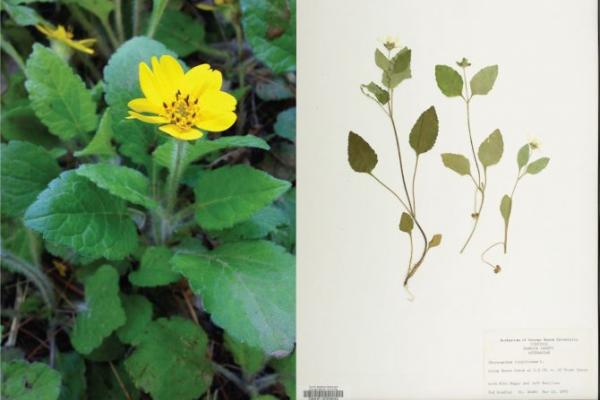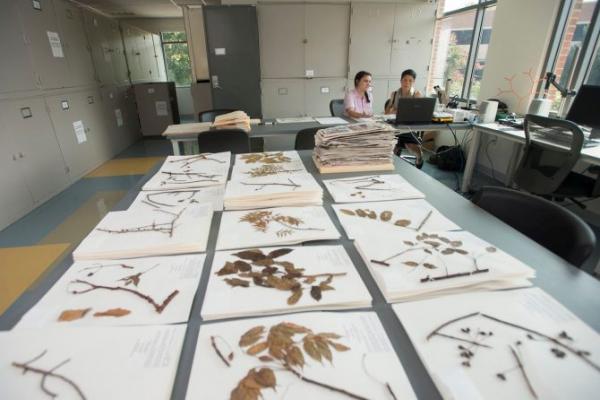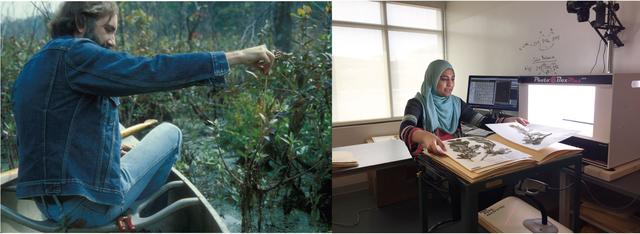The Ted R. Bradley Herbarium
Admission CTAs
An Introduction to the George Mason University Herbarium
The Ted R. Bradley Herbarium engages the next generation of botanists and champions the careful stewardship of Virginia’s plant diversity through hands-on education, collections-based research, and public outreach.
Mission
The Ted R. Bradley Herbarium engages the next generation of botanists and champions the careful stewardship of Virginia’s plant diversity through hands-on education, collections-based research, and public outreach.
Vision
The Ted R. Bradley Herbarium will grow as a regional center for plant diversity education and locally-relevant research that advances our understanding of and ability to preserve Virginia’s flora.
Educating the next-generation of botanists at Mason
The herbarium provides teaching resources for multiple university courses and research materials for undergraduate projects and graduate theses and dissertations. The herbarium sponsors an undergraduate student intern through the Turnage Trust Internship Program with Meadowlark Botanical Garden. Since 2015, the herbarium has been working with undergraduate students through the Patriot Green Fund program in developing the George Mason University Arboretum on the Fairfax campus.
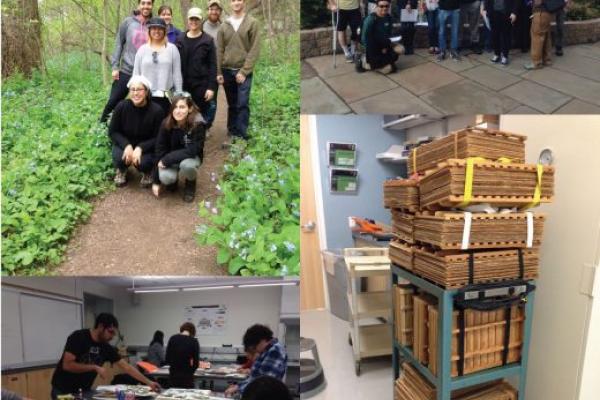
Collections-Based Research at Mason and Beyond
History
The collection was begun in 1967 by its first curator in the Department of Biology, Professor Ted Bradley. Dr. Bradley added thousands of collections over the course of his career and was instrumental in developing the Atlas of the Virginia Flora. By the time he retired in 2003, he had expanded the collection to over 60,000 specimens of vascular plants, non-vascular plants and lichens. Many of his specimens were used to create the Flora of Virginia (read more at http://floraofvirginia.org). Mason Professor James Lawrey has contributed thousands of lichen and lichenicolous specimens. Since 2005, Department of Biology Professor Dr. Andrea Weeks has curated the collection and incorporated it into her research program, as well.
Description of the Research Collection
The facility is located on the ground floor of Exploratory Hall and comprises separate rooms for specimen preparation and archival storage of the research collection. The majority of specimens (ca. 67%) are from Virginia, particularly Northern Virginia, and are separated in beige folders from other specimens in the cabinets. The remaining ca. 33% mainly derive from the southeastern US and are filed in yellow folders. International specimens, such as those from Canada, Puerto Rico, Andros Island (Bahamas), and South America, are further segregated into orange folders. The vast majority of these specimens are not duplicated elsewhere and are therefore irreplaceable documents of Virginia’s plant biodiversity heritage. The entire collection is arranged by family, alphabetically by genus and species, followed by geographical segregation at the species and sub-species level. The herbarium also maintains identification manuals, dissecting microscopes and field collecting equipment for use by Mason students and researchers.
World-wide Digital Access to the Research Collection
With support from the National Science Foundation (EF-1410086 “Digitization TCN: Collaborative Research: The Key to the Cabinets: Building and sustaining a research database for a global biodiversity hotspot) and the Virginia Native Plant Society, all Virginian vascular plant herbarium specimens of the Ted R. Bradley herbarium have been digitized and are searchable at http://www.sernecportal.org. The lichen and lichenicolous fungi specimen data are distributed through Consortium of North American Lichen Herbaria portal: https://lichenportal.org/cnalh/
Use by External Researchers
Recent external visitors to Mason’s collection include natural resource professionals from the Virginia Natural Heritage Program, NatureServe, US Geological Service, Fairfax County and the City of Alexandria. Botanists from outside Virginia also access the collections through loans of specimens to their institutions. Mason herbarium specimens have recently been used to support a range of non-Mason projects including a revised Flora of the Bahamas, a pollen flora of the Potomac River Basin, and phylogeographic study of Prunus serotina (Black Cherry).
Herbarium Specimen Curation for Global Research
With support from the National Science Foundation (EF-1410086 “Digitization TCN: Collaborative Research: The Key to the Cabinets: Building and sustaining a research database for a global biodiversity hotspot) and the Virginia Native Plant Society, all Virginian vascular plant herbarium specimens of the Ted R. Bradley herbarium have been digitized and are searchable at sernecportal.org.
Public Outreach
The herbarium hosts tours for members of the broader Mason community, children’s groups such as Girl Scout troops, and civic organizations such as the Vienna Garden Club, the Virginia Native Plant Society and the American Chestnut Foundation. Community engagement activities have included sponsoring a native plant rescue on campus, a workshop at the Sally Ride Science Festival, and training Virginia Master Naturalists.
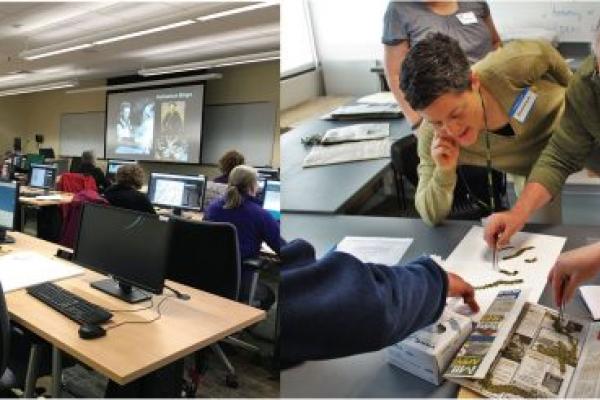
Theses and dissertations produced by Mason students since 2000 that have relied on the Ted. R. Bradley Herbarium
Masters’ theses
- McMurchie, Elizabeth. 2018. Vascular flora of Blue Ridge Environmental Center (Purcellville, Loudoun County).
- Oldham, Karoline. 2015. Taxonomic revision and phylogeographic study of American Cow-wheat (Melampyrum lineare; Orobanchaceae).
- North, Brittany. 2013. The response of the root and soil fungal communities to competition among Amphicarpaea bracteata, Onoclea sensibilis, and the invasive Microstegium vimineum in Northern Virginia.
- Smith, Matthew. 2011. Vascular flora of Crow’s Nest State Nature Preserve. Project-based.
- Alexander, Sara. 2010. A subspecific revision of North American saltmarsh mallow, Kosteletzkya pentacarpos (L.) Ledeb.
- Dee, Suzanne. 2010. Structural and functional development of vegetation in mitigation bank wetlands created in the piedmont region of Virginia.
- Baird, Kristen. 2009. The phylogenetics and historical biogeography of Leibnitzia Cass. (Asteraceae: Mutisieae): American species in an Asian genus.
- Williams, Lisa A. 2004. Floristic survey of the Eastern Goose Creek watershed, Loudon County, Virginia.
- Dodge, John E. 2000. A floristic survey of the Potomac River watershed in Westmoreland County, Virginia, from Bridges Creek to Currioman Bay.
- Lea, Christopher. 2000. Plant Communities of the Potomac Gorge and their relationship to fluvial factors.
Ph.D. dissertations
- Collins, Elizabeth. Ongoing. Revision and phylogeographic investigation of Bursera graveolens.
- Dal-Forno, Manuela. 2015. Systematics, phylogeny, and species taxonomy of the lichen genus Dictyonema.
- Gostel, Morgan. 2015. Origin and evolution of endemic Commiphora lineages of Madagascar.
- Hollowell. Thomas H. 2005. Plant community structure, fire disturbance, and recovery in mangrove swamps of the Waini Peninsula, Guyana.
- Strong, Mark T. 2004. An electron microscopy study of the outer pericarp surface of the achenes (fruits) of Rhynchospora (Cyperaceae) in the Guianas, South America, bearing on the delimitation of species and sections, and to clarify the taxonomy and distribution of species occurring in the Guianas.
- Kelloff, Carol Lynn. 2002. Plant diversity of Kaieteur National Park, Guyana: Using plant data as a tool in conservation and development.
Additional Information
Contact: Dr. Andrea Weeks
Campus Location: Exploratory Hall, L109 and L110
Policies for Visitors and Loans: GMUF Policies and Procedures
Shipping Address:
Department of Biology – Ted R. Bradley Herbarium
George Mason University
4400 University Drive MSN 3E1
Fairfax, Virginia 22030
USA
